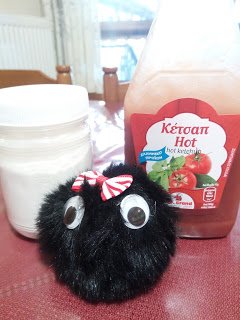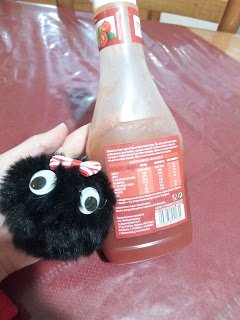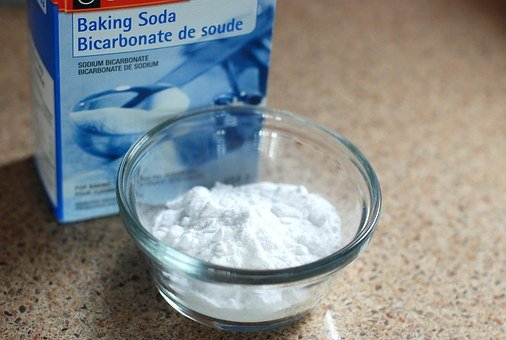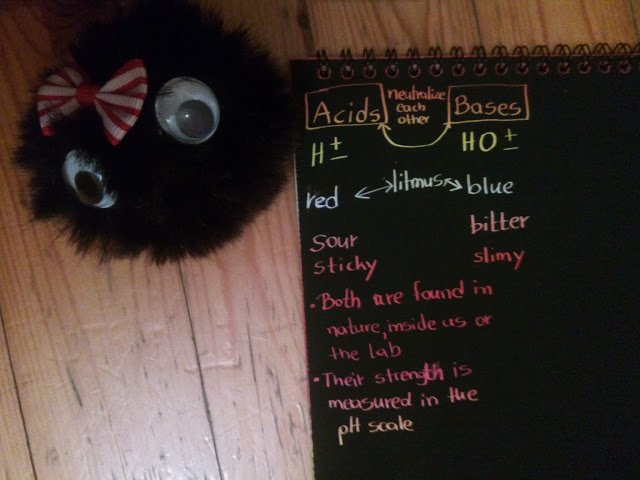So today I'm scrolling down my Facebook page and I stumble upon this prank video:
This guy pranks his girlfriend by adding bicarbonate soda in the ketchup bottle. When she opens the bottle it suddenly explodes and ketchup is all over the place (I wouldn't wish to be the one to clean it up).
I had two questions by the end of the video:
- Is the guy still alive or did his girlfriend kill him by making him eat a bottle of ketchup and then a few tablespoons of soda? (that was just the psychopath in me wondering)
- Why the hell did that happen?
After a little "googling" I found out that the reaction is pretty simple...


Images by @ruth-girl
If you take a look at the ingredients, ketchup has vinegar in it. Vinegar is acidic. Bicarbonate soda is basic. When those two substances mix together they form the same two-stages reaction that happened on the DIY rocket project my trolls made last month.
Here's a short ke-tch up (pun intended) on the chemistry:
The vinegar (CH3COOH) is an acid that reacts with the basic baking soda powder (NaHCO3). This reaction produces CO2 gas, water (H2O), sodium ion (Na+) and acetate ion (CH3COO-).
The first step of this reaction is:
NaHCO3 + HC2H3O2 > NaC2H3O2 + H2CO3
Where the soda or sodium bicarbonate (NaHCO3) reacts with the vinegar (HC2H3O2) and produce sodium acetate (NaC2H3O2) and carbonic acid (H2CO3).
In the second step the carbonic acid (H2CO3) produces water and carbon dioxide through a decomposition reaction.
H2CO3 > H2O + CO2
Apparently, bases can "neutralize" acids, but let's explain a little more about them
Acids
Originating from the from the Latin words for "sour" acidus or acere, an acid is a chemical substance that gives away protons or hydrogen ions and/or takes electrons. Most acids contain a hydrogen atom that when added in water it can be released to form an anion or cation.

(Image source: pixabay.com)
There are three definitions on acids:
- Arrhenius acids: substances that increase the concentration of hydrogen ions (H+) or hydronium ions (H3O+) when they're added in water.
- Bronsted-Lowry acids: substances that give a proton to a Bronsted-Lowry base (proton donor). This is a broader definition, since it's not limited to water and is the most widely used.
- Lewis acids: substances that accept a pair of electrons from another species (electron pair acceptor). According to this categorization, non-hydrogen substances can qualify as acids.
Their main properties are:
- They have a pH less than 7.
- They have sour taste.
- They leave a burning sense of smell.
- They are sticky in touch.
- They are corrosive.
- They can change litmus color (a blue vegetable dye) from blue to red.
- Their aqueous solutions are electricity conductors.
- They react with a base to form salts and water.
- They react with active metals and release hydrogen (H2) gas.
Bases
Bases work as proton acceptors and/or contain completely or partially displaceable hydroxide ions (OH-).

(Image source: pixabay.com)
There are also three definitions for bases:
- Arrhenius bases: substances that release hydroxide ions (OH-) in an aqueous solution. This term is quite restricting since it involves the presence of hydroxide in the original substance.
- Bronsted-Lowry bases: substances that accept hydrogen cations (H+).
- Lewis bases: substances that give away an electron pair (electron pair donor).
Their basic (another pun here) properties are:
- They have a pH greater than 7.
- They have a bitter taste.
- They are slippery in touch.
- They usually don't smell (except for ammonia).
- They can change acidified litmus color from red back to blue.
- Their aqueous solutions are electricity conductors.
- They react with fats and oils.
Weak or Strong?
We define acids as weak or strong by their ability to dissociate into H+ and anions when added in water (dissociate meaning dissolve, break down to). The stronger an acid is the more it dissociates in water. A base dissociates into HO- and cations when added in water. The stronger it is, the more it dissociates.
The concentration of released ions determines the strength which is measured in the pH scale. Numbers range from 0-14, but there can be negative pH for extremely strong acids and pH greater than 14 for very strong bases.

(Image source: commons.wikimedia.org)
Let's revise it in short:

Image by @ruth-girl
Most common acids and bases
Acids and bases are everywhere. You can find acids in lemons, batteries, even your stomach, and bases in all your detergents as they work pretty well with removing dirt and fat.
Some of the most widely known acids are:
- hydrochloric acid (HCl): with many industrial and lab uses, it is also present in our stomach fluids.
- acetic acid (HC2H3O2): found in vinegar.
- boric acid (H3BO3): widely used for pesticides and disinfectants.
- carbonic acid (CH2O3): it forms weak solutions (like carbonated water).
- citric acid (H3C6H5O7): contained in citrus fruit, it is used as flavoring and an acidifying agent in food industry.
- nitric acid (HNO3): or aqua fortis, it is used in the making of explosives and inks and as a strong oxidizer for industrial and lab use.
- sulfuric acid (H2SO4): it is used in lead batteries, drain cleaners, and chemical synthesis.
Some of the most widely known bases are:
- sodium carbonate (Na2CO3): used in dish detergents.
- ammonium hydroxide (NH4OH): used in glass cleaners.
- aluminum hydroxide (Al[OH] 3): used in antacids and deodorants.
- sodium hypochlorite (NaClO): used in bleach.
- sodium bicarbonate/sodium hydrogen carbonate (NaHCO 3): the common baking soda used in cooking.
And here is a short video to go with it:
References
prankked.com
ducksters.com
wikipedia.org_1 - wikipedia.org_2
thoughtco.com_1 - thoughtco.com_2 - thoughtco.com_3
scienceclarified.com

Thank you for stopping by and giving this post a read. I hope you enjoyed it! If you please, feel free to pay a visit to my blog and check out my short stories along with plenty of educational posts and of course my bizarre natural phenomena series.
Special thanks and mentions go to:

Until my next post,
Steem on and keep smiling, people!



